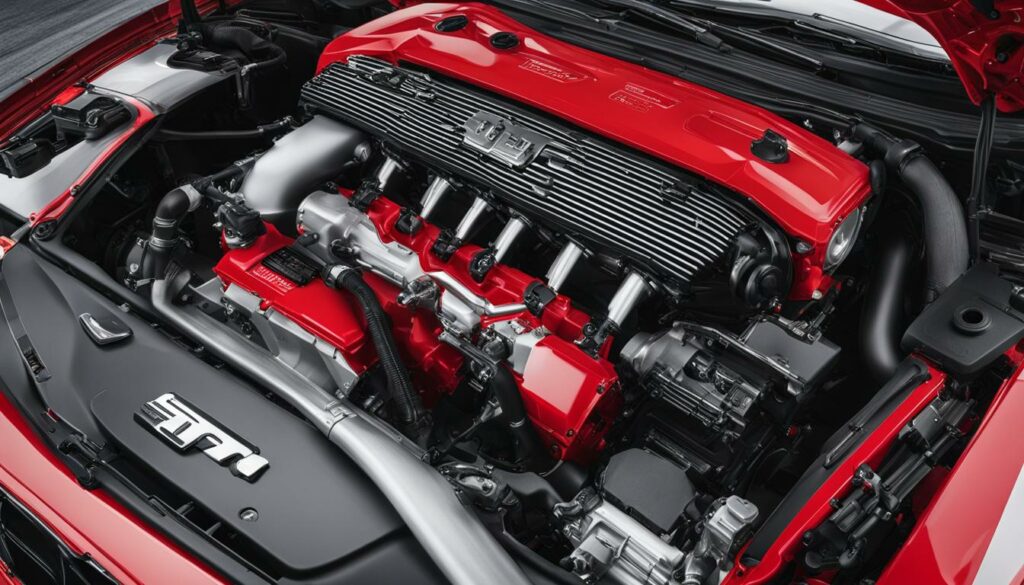P0173 – Fuel Trim Malfunction Bank 2
POSTED IN pcodes
Welcome to our informative article on the P0173 code, specifically the fuel trim malfunction in bank 2. If you’re experiencing engine performance issues or have encountered this diagnostic trouble code, you’ve come to the right place. We’ll provide you with an understanding of what the P0173 code means, its common causes, symptoms, and how to diagnose and fix the issue.
Key Takeaways:
- The P0173 code indicates a fuel trim malfunction in bank 2.
- Common causes include air vacuum leaks, exhaust leaks, oxygen sensor malfunction, and fuel delivery problems.
- Symptoms of a P0173 code include poor fuel economy, hesitation during acceleration, and intermittent stalling.
- Diagnosing and fixing the issue may require professional assistance and specialized tools.
- Ignoring the P0173 code can lead to further engine performance issues and potential damage to your vehicle.
Understanding the P0173 Code
The P0173 code points to a fuel trim malfunction in bank 2 of a vehicle’s engine. This diagnostic trouble code indicates that the fuel mixture in the engine has deviated from the optimal air-fuel ratio, either becoming too lean or too rich. The fuel trim refers to the adjustments made by the powertrain control module (PCM) to maintain the proper balance of fuel and air. When the PCM reaches its operational limits in adjusting the fuel trim, the P0173 code is triggered.

What is Fuel Trim?
Fuel trim is a crucial aspect of engine performance, as it ensures that the air-fuel mixture is optimally balanced for efficient combustion. The fuel trim system continuously monitors and adjusts the air-fuel mixture based on inputs from various sensors, including the oxygen sensors. By analyzing the oxygen levels in the exhaust gases, the PCM can determine whether the engine is running too rich or too lean, and then adjust the fuel delivery accordingly. This ongoing adaptation aims to maintain optimal engine performance and reduce emissions.
Role of Bank 2 in Fuel Trim Malfunction
In a V6 or V8 engine, the cylinders are divided into two banks: bank 1 and bank 2. Bank 2 is typically responsible for monitoring and adjusting the fuel trim on one side of the engine. When the P0173 code specifies a fuel trim malfunction in bank 2, it means that the air-fuel mixture imbalance is occurring on that side of the engine. The identification of bank 2 helps pinpoint the location of the issue and aids in the diagnostic process.
Buy tested tuning file for Adblue / EGR / DPF / Adblue off now!
| Cause | Description |
|---|---|
| Air Vacuum Leaks | Air leaks in the intake manifold or vacuum lines can introduce additional unmetered air, disrupting the air-fuel ratio. |
| Exhaust Leaks | Leaking exhaust components can contaminate the air-fuel mixture, leading to fuel trim imbalances. |
| Oxygen Sensor Issues | Malfunctioning oxygen sensors may provide inaccurate readings, causing improper fuel adjustments. |
| Fuel Delivery Problems | Issues with the fuel pump, injectors, or fuel pressure regulator can disrupt the fuel delivery, leading to fuel trim malfunctions. |
Common Causes of the P0173 Code
The P0173 code can be triggered by several common causes that result in a fuel trim malfunction in bank 2. These causes include:
- Air Vacuum Leaks: When there are leaks in the vehicle’s intake manifold, vacuum hoses, or throttle body gasket, it can disrupt the air-fuel ratio and trigger the P0173 code. These leaks allow unmetered air to enter the engine, leading to an imbalance in the fuel mixture.
- Exhaust Leaks: Leaks in the exhaust system, such as cracked or damaged exhaust manifolds or gaskets, can result in the P0173 code. These leaks affect the oxygen sensors’ ability to measure the air-fuel ratio accurately.
- Malfunctioning Oxygen Sensors: Faulty oxygen sensors can provide incorrect readings of the air-fuel ratio, leading to a fuel trim malfunction. These sensors play a crucial role in the engine management system and can impact the fuel delivery process.
- Faulty Mass Air Flow Sensors: Mass air flow sensors measure the amount of air entering the engine to calculate the necessary fuel injection. If these sensors malfunction, incorrect air measurements can occur, causing a fuel trim imbalance.
- Circuit Issues: Problems in the circuitry of the fuel control system, such as faulty wiring or connectors, can disrupt the communication between the sensors and the PCM. This disruption can result in inaccurate fuel trim adjustments and trigger the P0173 code.
- Fuel Delivery Problems: Issues with the fuel delivery system, such as clogged fuel injectors, a malfunctioning fuel pump, or a restricted fuel filter, can lead to an improper fuel mixture. These problems can result in a fuel trim malfunction and the activation of the P0173 code.
Note: It’s essential to address these common causes promptly to prevent further engine performance issues and potential damage to the vehicle.

Example Table Title
| Common Causes of the P0173 Code | Description |
|---|---|
| Air Vacuum Leaks | Leaking intake manifold, vacuum hoses, or throttle body gasket |
| Exhaust Leaks | Cracked or damaged exhaust manifolds or gaskets |
| Malfunctioning Oxygen Sensors | Faulty sensors providing inaccurate air-fuel ratio readings |
| Faulty Mass Air Flow Sensors | Malfunctioning sensors affecting air measurement |
| Circuit Issues | Problems in the fuel control system’s circuitry |
| Fuel Delivery Problems | Clogged fuel injectors, malfunctioning fuel pump, or restricted fuel filter |
Symptoms of a P0173 Code
When your vehicle’s diagnostic trouble code shows P0173, it indicates a fuel trim malfunction in bank 2. This malfunction can lead to several symptoms that should not be ignored. Recognizing these symptoms promptly can help prevent further engine performance issues and potential damage to your vehicle.
One of the most noticeable symptoms of a P0173 code is hesitation during acceleration. You may experience a lack of power or a delay in response when pressing on the gas pedal. This hesitation can be concerning, especially when merging onto a highway or trying to quickly pass another vehicle.
Poor fuel economy is another common symptom of a P0173 code. If you notice that you’re going through fuel faster than usual or if your miles per gallon have significantly decreased, it could be a sign of a fuel trim malfunction in bank 2. This symptom can impact your wallet and reduce the overall efficiency of your vehicle.
Intermittent stalling is also associated with a P0173 code. Your vehicle may stall unexpectedly, especially when idling or coming to a stop. This can be a safety concern, especially if it happens in traffic or at intersections.
Key Symptoms of a P0173 Code:
- Hesitation during acceleration
- Poor fuel economy
- Intermittent stalling
If you’re experiencing any of these symptoms, it’s important to have your vehicle inspected and diagnosed by a professional. Ignoring a P0173 code and its symptoms can lead to further engine performance issues and potentially expensive repairs.
Comparing Symptoms of a P0173 Code
| Symptoms | Causes |
|---|---|
| Hesitation during acceleration | Imbalanced air-fuel ratio due to fuel trim malfunction in bank 2 |
| Poor fuel economy | Disrupted air-fuel ratio caused by the P0173 code |
| Intermittent stalling | Fuel trim malfunction leading to engine instability |
Please note: It’s crucial to consult a qualified automotive technician to accurately diagnose and address a P0173 code and its associated symptoms. They have the expertise and tools necessary to identify and resolve the underlying issue, ensuring the optimal performance and longevity of your vehicle.
Diagnosing and Fixing a P0173 Code
Diagnosing a P0173 code can be challenging, as it requires expertise and specialized tools. When faced with a fuel trim malfunction in bank 2, it is recommended to seek professional assistance to accurately diagnose and fix the issue. A mechanic experienced in diagnosing P0173 codes can perform a series of tests to pinpoint the underlying problem.
One of the essential tests is checking for air vacuum leaks. These leaks can disrupt the air-fuel ratio and trigger the P0173 code. A mechanic will thoroughly inspect the engine for any signs of leaks, such as damaged hoses or gaskets. By identifying and repairing these leaks, the fuel trim can be restored to normal operation.
Another critical component to inspect is the oxygen sensor. Malfunctioning oxygen sensors can provide inaccurate readings, leading to a fuel trim malfunction. Mechanics will use specialized diagnostic tools to test the sensors’ functionality and determine if they need to be replaced.
Additionally, the fuel delivery system should be tested to diagnose a P0173 code accurately. This involves inspecting the fuel injectors, fuel pressure regulator, and fuel pump. A mechanic can use pressure gauges and other equipment to measure fuel pressure and flow rate, ensuring that the fuel system operates within the specified parameters.
Based on the specific cause of the P0173 code, the mechanic can then recommend the appropriate repairs or replacements. This may include replacing faulty sensors, repairing leaks, cleaning or replacing fuel injectors, or conducting a thorough fuel system cleaning.
Common Diagnostic Procedures for P0173 Code
| Diagnostic Procedure | Description |
|---|---|
| Check for air vacuum leaks | Inspect the engine for leaks in hoses, gaskets, and vacuum lines that can disrupt the air-fuel ratio |
| Inspect oxygen sensors | Test the functionality of the oxygen sensors using diagnostic tools, replace if necessary |
| Test fuel delivery system | Inspect fuel injectors, fuel pressure regulator, and fuel pump for proper operation and replace any faulty components |
| Recommend repairs or replacements | Based on the diagnostic findings, recommend appropriate repairs or replacements to address the P0173 code |
It is important to address a P0173 code promptly to prevent further engine performance issues and potential damage to the vehicle. Seeking professional assistance will ensure accurate diagnosis and effective resolution of the fuel trim malfunction in bank 2.
Conclusion
The P0173 code is a common diagnostic trouble code that indicates a fuel trim malfunction in bank 2. This issue can arise due to various factors such as air vacuum leaks, malfunctioning sensors, circuit issues, and fuel delivery problems. If you encounter a P0173 code, it is crucial to address it promptly to prevent further engine performance issues and potential damage to your vehicle.
To effectively diagnose and repair a P0173 code, it is recommended to seek professional assistance. Skilled mechanics have the expertise and specialized tools necessary to accurately identify the underlying cause of the code. By conducting tests like checking for air vacuum leaks, inspecting sensor functionality, and testing the fuel delivery system, they can provide precise solutions for your specific situation.
Ignoring a P0173 code can have detrimental effects on your vehicle’s performance and longevity. Therefore, it is advisable to consult a professional as soon as possible. Remember, timely intervention can save you from costly repairs down the line and ensure optimal engine operation.
FAQ
What does the P0173 code indicate?
The P0173 code indicates a fuel trim malfunction in bank 2, meaning the fuel mixture has become too lean or too rich.
What are the common causes of the P0173 code?
The P0173 code can be caused by air vacuum leaks, exhaust leaks, malfunctioning oxygen sensors, faulty mass air flow sensors, circuit issues, or fuel delivery problems.
What are the symptoms of a P0173 code?
The symptoms of a P0173 code include hesitation during acceleration, poor fuel economy, and intermittent stalling.
How can a P0173 code be diagnosed and fixed?
Diagnosing a P0173 code requires expertise and specialized tools. It is recommended to seek professional assistance to accurately diagnose and fix the issue. A mechanic can perform tests and recommend the appropriate repairs or replacements based on the specific cause of the code.


